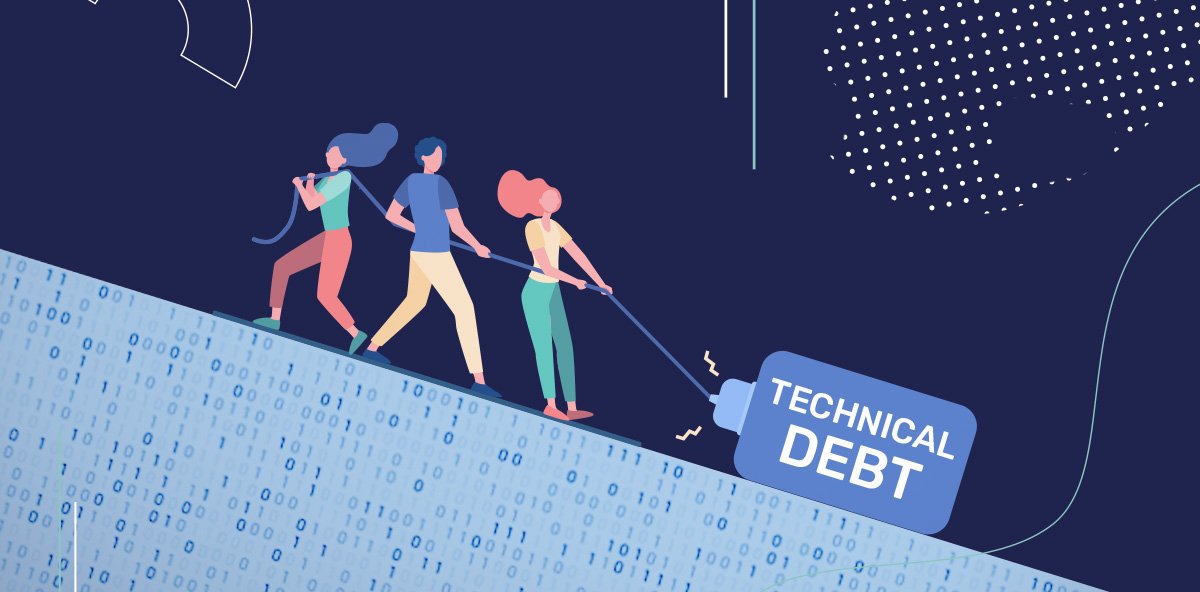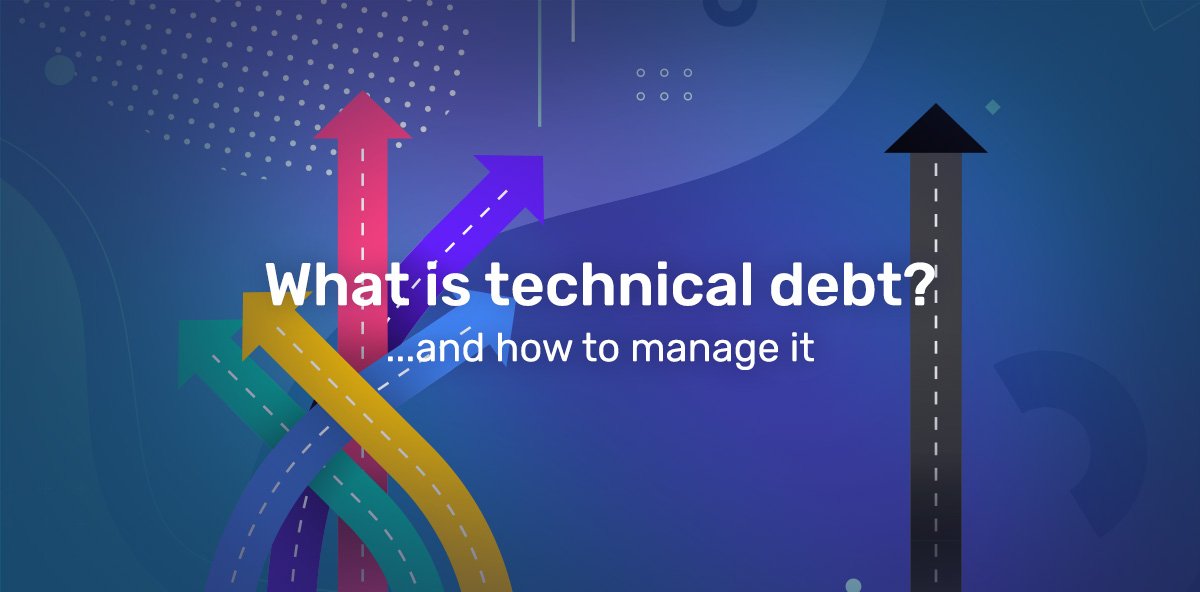Every experienced company knows the concept of financial debt. There are advantages and disadvantages to using this solution. A similar phenomenon also exists in the software development process. Discover what technical debt is and the consequences that come with it. You will find that the two terms have much more in common than the name itself.
As a rule, people have negative associations with the word “debt”. Does incurring debts always have to be a necessary evil? Absolutely not. Of course, financial debt can lead to debt collection, but this solution is successfully used by many companies around the world. External financing (e.g. credit) allows them to maintain financial liquidity and is often the driving force behind the development of innovation.
The technical debt in software development works on a similar basis. Depending on the situation, it can harm you a lot, but when used in the right way, it will support the development of your digital project. Stepwise’s experience has shown that controlled incurring of this debt can prove very useful in the software development process. What is technical debt?
Technical debt is a phenomenon that exists with every project. Whether you take it consciously or not, it will have to be repaid someday. Certain deficiencies that are not as significant on a smaller scale can become a huge problem when scaling a project. Due to the inevitability of this phenomenon, proper management of technical debt is crucial.
What is technical debt?
In the software development process, you may be faced with the choice of applying cheap and simple technology or investing more resources in better solutions. Technical debt appears when you prefer fast project implementation time and low production cost over software quality.
It can also be said that technical debt is the cost of the work that needs to be done to add a new solution, without loss of system operation. It tells us how long it takes to deliver new functionalities in software that does not meet the current needs of the business.
Choosing a cheap and fast “now” route may seem tempting, but it has various consequences in the future, such as the need to incur additional costs and labor to repair or refine your product. However, this is not always a negative phenomenon.
Technical debt can be incurred in many ways.
Reckless technical debt can cause a lot of problems and complications. You waste money and time to fix bugs in your code. Unconscious and reckless debt can arise when an inexperienced team sits down to code and does not know good design practices, such as activity planning or control tests. Such people incur a debt without realizing what trouble they are in.
Technical debt can be compared to the construction of a skyscraper by a construction team that does the construction of detached houses on a daily basis. Such a team does not take into account the client’s needs and approaches the construction of a complicated complex in the city center as if it were to build a one-story house in the suburbs. The team lacks experience, and as a result, a comprehensive design or a media connection plan is not created, the underground garage, alarm system and other necessary parts of the building are also forgotten. The team also does not take into account the changing climatic conditions. Such a structure can fall apart very quickly like a house of cards.
Likewise, unconscious debt is when the team only deals with coding. In this case, developers do not pay attention to the broader context of the project and do not plan any activities. There is no proper development of the system architecture and automation of the software development process. With an unaware debt, the software house does not try to understand the client’s business needs. Code quality is poor and no good software development practices are followed.
Some teams, however, incur a reckless debt on purpose. This is also a negative phenomenon. It occurs when programmers only want to “tick off” a task and speed up project activities, without proper project preparation and without thinking about the client’s business and success.
Reckless debt, even if on purpose, is usually incurred by inexperienced teams. Such people lack commitment to the client’s success. The main priority is technology, not the business effect. Developers often use well-known but outdated technologies that have either been suspended or will face it in the near future. This poses a big problem in acquiring additional resources and scaling the project. Reliable software houses know that in each project business is always the most important. Read more about reliable software houses here. Check our services!
This situation can be compared to the renovation of a house with the help of a team that, instead of applying to your needs, using the best materials that will serve you for years and carrying out the renovation reliably, it does it at its own discretion, uses difficult or weak materials, and the effect of their work is comparable to the interior design from the times of the great concrete slab of the Polish People’s Republic.
Reckless deliberate debt is the result of the work of a software house, which is more on its own ambitions than on meeting your business needs. At Stepwise we avoid such situations and prove to ourselves and our clients whether a given solution makes sense, for example by using PoC (Proof of Concept). You can learn more about PoC here.
Sometimes the customer may not have a clue of the existence of a debt that has arisen recklessly until the software audit or critical errors occur while using the program
Cautious technical debt usually occurs in projects carried out by experienced and reliable software houses. Consciously incurring such a debt can bring many benefits, e.g. check the market potential of the product using the minimum possible resources, especially when TTM (Time To Market) is relatively short.
Stepwise successfully uses controlled technical debt in a situation where the client wants to safely and quickly assess the chances of the success of their venture, without having to invest in the entire system. When incurring such a debt, it is important to assess whether adopting a project strategy that brings short-term benefits will be profitable in the future, despite the need to pay off the debt.
One solution you can use is MVP (Minimum Viable Product). This solution is based on the efficient creation of a digital product that contains only the necessary functionalities. End users can test it, and the collected feedback allows them to make the right decisions related to the further development of the project. You can learn more about MVP here.
Careful technical debt is a natural phenomenon that accompanies software development and changes in application vision. As the product grows and increases its potential from local to global, effective scaling processes and functionalities related to effective management of computing resources, machine learning (ML) and data processing and Data analytics become essential. A modern approach to the business of experienced companies is based on data. Even if the customer does not consider such issues at the beginning, they are of great importance as the product develops and gains popularity.
Technical debt is an inseparable part of every project. Even the best teams will have debts to deal with during product development. Sometimes prudent technical debt is incurred unintentionally. This type of debt is unavoidable and must always be expected. Even when the project is successful, the client and team are satisfied with the result of their work, and the code does not contain any errors. After completing their activities, however, developers discover new, better ways to code, design the application or integrate technology. This is where the inadvertent variation of prudent debt comes into play.
The best software houses can even turn an inadvertently incurred careful debt into profits for themselves and their clients. There is a valuable lesson to learn from every conscious debt. Stepwise uses this experience and knowledge in subsequent projects. Each new product we create is the result of all orders that we have completed in the past.
How is technical debt created?
Software development is a complex process and its success depends on many factors. A reliable software house like Stepwise takes care of every element of this process. However, it is not difficult to find companies less experienced in the software development process, which are not able to provide comprehensive quality at every stage of the project. In such cases technical debt is most often created by errors in the code, by the wrong choice of technology or the lack of tests, but that is definitely not all.
Factors that influence software quality:
- Ongoing business requirements
- Concepts and solutions (e.g. the framework or system architecture used)
- Automation in software development
- Organization structure (e.g. ease of communication, commitment)
- Quality of the original code (if any)
- Synergy and interpersonal skills in the team
- Best practices in software development (work methodology, Product Owner involvement)
- Technology scouting – verifying the latest available technologies (so as not to reinvent the wheel)
All these factors have a real impact on the build-up of technical debt. Sometimes, however, the cause of product problems may be, for example, poor management of the software development process, and not necessarily technical debt. This is important to remember.
If the number of errors in the project builds up, then after some time it may turn out that we are actually dealing with an unconscious debt. This, on the other hand, involves the need to refactor the system, fix errors and additional expenses.
If the code is well managed and you know when to take advantage of technical debt, the project is evolving and can be easily adapted to your current needs. Stepwise always educates its clients in this regard. The software development methods developed by us allow you to incur technical debt in a conscious manner.
The most important thing is to document and analyze the debt incurred on an ongoing basis and, if possible, repay the debt as the work progresses. Paying off your debt in installments hurts less than a high tranche after a few months or years.
We know the business well and try to thoroughly understand the needs of our clients. It happens that the deadline for introducing a product to the market is urgent. Sometimes investors need to confirm the commercial potential of a client’s product and until then they can operate on a limited budget. For these reasons, Stepwise enables controlled incurring of technical debt. It is necessary to assess whether such action will be profitable in the context of the entire project and how easy it will be to pay it back.
Paying off technical debt
In order to pay off the technical debt, you have to be aware that such a phenomenon exists from the very beginning. Then you can effectively manage it, control the amount of the debt and pay the installments on an ongoing basis. If the debt is incurred unconsciously, paying it off can either be impossible or very costly and time-consuming. It all depends on when you realize it exists.
Technical debt is relatively easy to pay off only if you incur it in a conscious and controlled manner. At Stepwise, when creating software, we always try to anticipate changes in business needs, in the technology used, and take into account the potential scaling of the project. Thanks to this, technical debt serves the customer instead of harming.
Appropriate planning of activities is essential in deliberately incurring technical debt. Developing an accurate design strategy takes time and effort, but is cost effective as it also takes into account future software evolution.
You can save in a short time by neglecting your strategy design, but the accumulated technical debt will eventually slow down your product development. Good practices of designing software development strategies improve its durability, enabling effective development at every stage.
Technical debt is a phenomenon that exists in any digital project. Only the most experienced and reliable software houses are aware of this. The most important thing is to consciously take it so that it helps in the future.
It is primarily customers who should be aware of the debt they incur and all its negative and positive consequences. At Stepwise, we are committed to respectful and mutual trust cooperation. Therefore, when the client makes key decisions in the project, we make sure that they have full knowledge of the potential effects of choosing a given solution.
Who should pay special attention to the phenomenon of technical debt?
Entrepreneurs / Visionaries – great minds are often ahead of their time. Business is not only a vision, but also achievable, measurable results. Technology serves business, but you have to remember about the necessary compromises between the idea and practical operation of software.
Startups – young organizations focused on dynamic development drive the economy and the development of innovation. However, a great business idea does not always come with knowledge of the software development process. Experience and necessary information are best obtained from an experienced software house.
Developers – IT specialists must be aware that working on a product is a process, working with business, and challenges. These aspects extend far beyond development itself. Each product should be treated individually. Technical debt is always a part of every project – this awareness allows it to be used in a controlled manner that serves the business.






